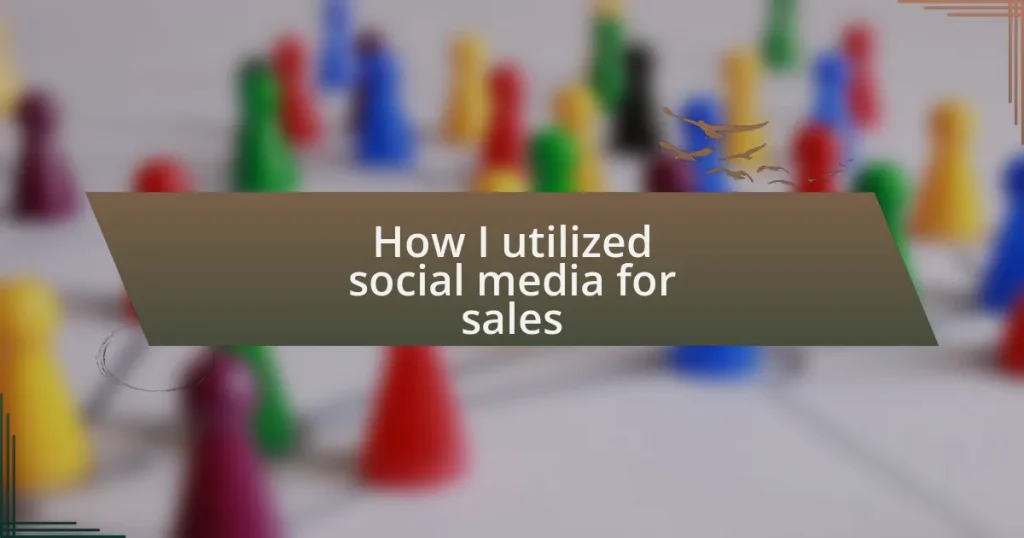Key takeaways:
- Social media is a powerful tool for sales, requiring an understanding of the unique nuances of each platform to effectively engage audiences.
- Crafting engaging content based on audience preferences and pain points can transform potential customers into loyal followers.
- Analyzing engagement metrics and adapting strategies based on audience response is crucial for optimizing social media performance.
- Feedback from the audience can guide content creation and lead to more effective marketing strategies, like developing relevant webinars.
Understanding social media for sales
Social media isn’t just a platform for connection; it’s a powerful tool for sales. I vividly remember launching a targeted campaign for my web design services on Instagram. The thrill of watching engagement soar as potential clients reached out was exhilarating; it transformed my approach to sales entirely.
Understanding the nuances of each platform is crucial for effective selling. For instance, I found that Twitter’s fast-paced nature suits brief updates and quick responses, while LinkedIn’s professional environment allows for deeper connections. How do we leverage these differences to enhance our sales strategies? It’s all about experimenting and finding what resonates with your audience.
I often reflect on the emotional aspect of social media. When I shared behind-the-scenes glimpses of my design process, I noticed an uptick in interest and trust. This connection makes a difference—people don’t just buy a service; they buy into a story. Have you considered how your own narrative could convert visitors into clients? It’s an empowering realization that fuels my ongoing social media efforts.
Crafting engaging content for audiences
Crafting engaging content requires a deep understanding of your audience’s preferences and pain points. I remember tailoring a series of posts for my web design services that highlighted common struggles clients face when designing a website. Each post sparked conversations and inquiries, drawing in potential clients who felt understood and connected. Have you ever considered how addressing your audience’s challenges can turn them into engaged followers?
Visual storytelling has been a game changer in my content strategy. I shared before-and-after images of website redesigns, showing not just the technical aspects but the emotional journey of my clients. One particular post showcasing a small business’s transformation resulted in several inquiries. It made me realize that when people see the impact of your work, they can envision their own success. How could your visuals speak to potential customers and inspire their trust?
Additionally, consistency is vital in maintaining engagement. I’ve established a regular posting schedule that keeps my audience anticipating new content. This approach has fostered loyalty and created a sense of community around my brand. Have you thought about how your posting frequency affects your audience’s connection? By staying present in their feeds, I find that I remain top-of-mind when they need web design services.
Analyzing results and optimizing performance
Analyzing the results of my social media strategy has been eye-opening. I frequently review engagement metrics like likes, shares, and comments to gauge what truly resonates with my audience. One campaign focusing on client success stories, for example, not only received higher engagement but also led to a spike in inquiries. Reflecting on this, I wondered: how well do you know what content your audience connects with the most?
To optimize performance, I’ve learned to adapt my strategy based on analytics. When I noticed that video content significantly outperformed static posts, I pivoted my focus to create more dynamic visual content. For instance, a short design tips video garnered twice the views of my previous posts. It made me realize that agility in content strategy can lead to substantial growth. What adjustments are you willing to make to align with your audience’s preferences?
Moreover, feedback loops are instrumental in refining my approach. I actively solicit input from my followers to understand their needs better. This iterative process led to the development of a webinar series on web design basics, which not only attracted participants but also built trust with my audience. Have you tapped into your audience’s insights to guide your content creation? Their feedback could be the key to unlocking your next big idea.
